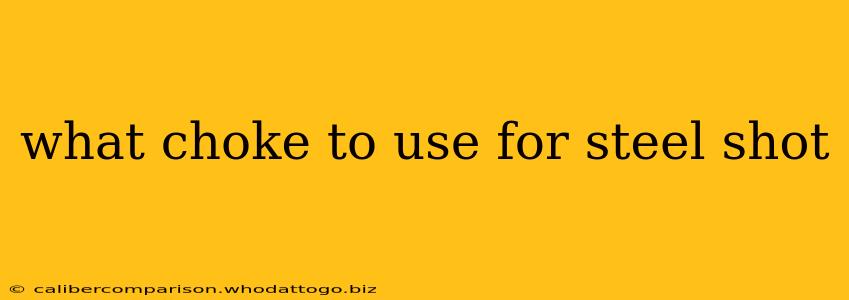Shooting steel shot requires a different approach than using lead, primarily due to steel's hardness and the resulting increased wear and tear on your firearm. Choosing the right choke is crucial for achieving optimal patterns and maximizing your hunting success. This guide will delve into the intricacies of selecting the appropriate choke for steel shot, considering various factors and offering practical advice.
Understanding the Impact of Steel Shot on Chokes
Steel shot is significantly harder than lead, leading to accelerated erosion within your gun barrel. This increased wear necessitates careful consideration of choke selection. Using the wrong choke with steel shot can result in poor patterns, reduced range, and even damage to your firearm.
Choke Types and Their Suitability for Steel Shot
Several choke types are available, each affecting shot pattern density and spread. However, not all are suitable for steel. Here's a breakdown:
Improved Cylinder (IC):
- Pattern: Provides the widest pattern, ideal for close-range shooting where a wider spread is beneficial.
- Steel Shot Suitability: Generally safe, but not ideal for long-range shots due to the significant pattern dispersion.
Modified (Mod):
- Pattern: Offers a balance between range and pattern density. A popular choice for many hunting situations.
- Steel Shot Suitability: A good all-around option for steel shot, particularly for medium-range shots at upland birds or waterfowl.
Improved Modified (IM):
- Pattern: Tighter than Modified, offering improved range and pattern density.
- Steel Shot Suitability: Suitable for medium to long-range shots, depending on the specific load and target.
Full:
- Pattern: The tightest choke, maximizing range and pattern density.
- Steel Shot Suitability: Use with caution. The tight constriction can increase barrel wear significantly and may not always yield optimal patterns with steel shot, especially with heavier loads. It's generally not recommended for steel shot unless specifically designed for it.
Extra Full:
- Pattern: Extremely tight constriction; generally not recommended for steel shot.
- Steel Shot Suitability: Avoid using an Extra Full choke with steel shot. The risk of damaging your barrel and obtaining poor patterns is high.
Factors Influencing Choke Choice
Beyond the basic choke types, several other factors influence your selection:
Shot Size:
Smaller shot sizes (e.g., #6, #4) generally benefit from slightly tighter chokes than larger shot sizes (e.g., BB, #2). Smaller shot is more susceptible to deflection, requiring a tighter pattern for accuracy.
Shot Load:
Heavier shot loads may require a slightly more open choke to maintain effective patterns, especially at longer ranges.
Distance to Target:
The distance to your target is arguably the most critical factor. Close-range shots necessitate open chokes, while longer ranges often demand tighter patterns (though always within the safe limits for steel shot).
Type of Game:
Different game requires different shot patterns. Upland bird hunting may benefit from a Modified or Improved Modified choke, while waterfowl hunting might use a Modified or even an Improved Cylinder, depending on the distance and bird size.
Steel Shot-Specific Chokes
Many manufacturers produce chokes specifically designed for steel shot. These often incorporate features that mitigate wear and tear while optimizing pattern performance. Look for chokes explicitly marked as "steel shot compatible."
Conclusion: Finding the Right Balance
Choosing the right choke for steel shot is a balancing act. You need to consider the potential for barrel wear while ensuring adequate pattern density and range for your target. Start with a Modified choke and experiment to find what works best for your specific firearm, shot size, load, and hunting situation. Always consult your firearm's manual for recommendations on choke types and safe usage with steel shot. Remember, safety should always be your top priority.

